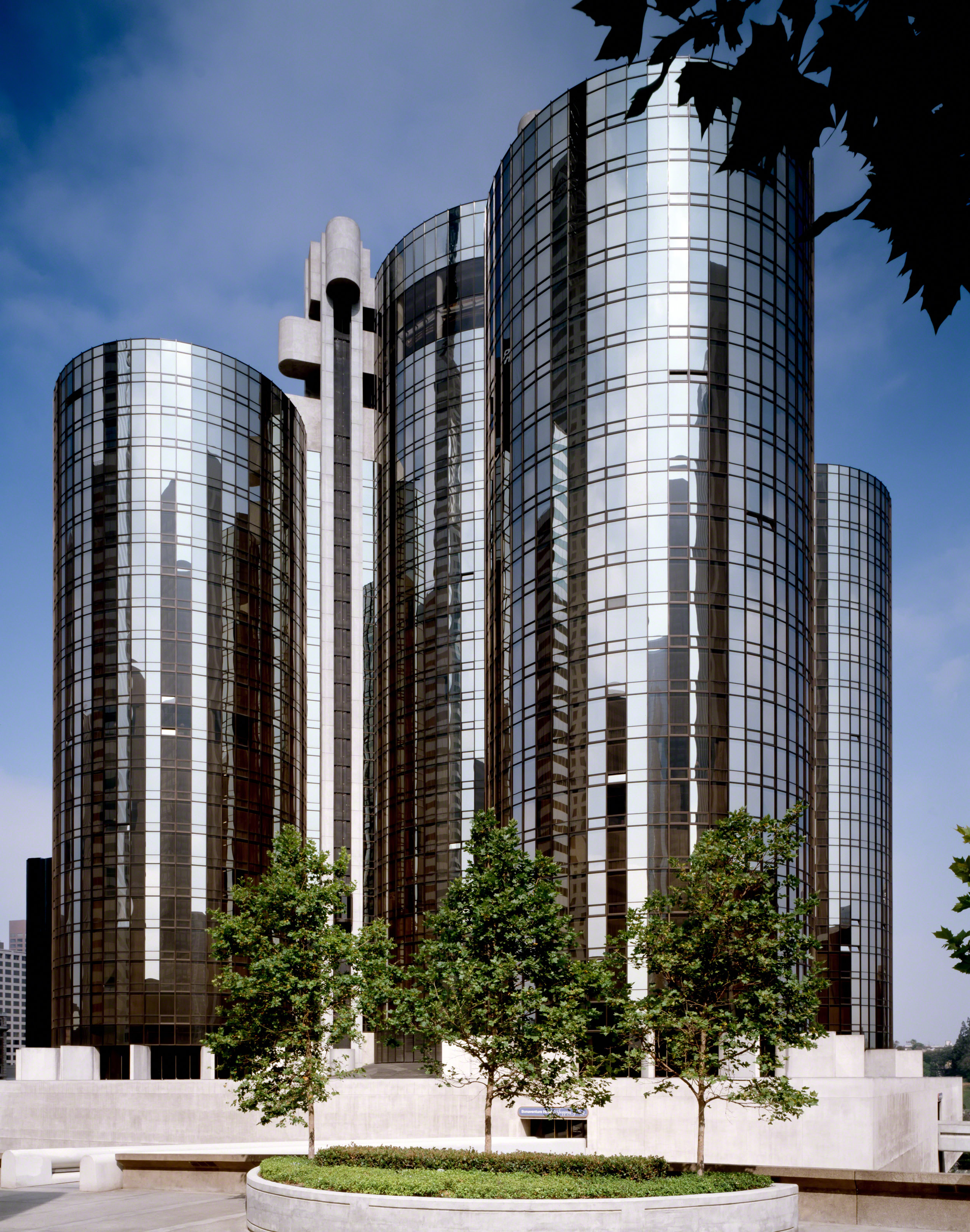Enjoy Yourself, Dare To Have New Experiences
Westin Bonaventure, exterior, elevated view to northwest, May 1989 Michael Portman, The Westin Bonaventure Collection
Text by Oliver Maxwell Kupper
Images courtesy of The Portman Archives
It must have been a thousand car rides before I fell in love with its ominous pulchritude, its black gleam at twilight, its dark visage and shelter for temporary domesticity. It has a violent, romantic aura that is fragile, but severe — invincible, but tenuous. There is a lonely reflective nature to the hotel in daylight, but a haunting glory at night, as the edifice disappears — like a body floating to the bottom of the ocean floor — leaving only its yellow-tinted windows half obscured by drapes and the occasional human silhouette. Yet there is always a quixotic elegance to the Westin Bonaventure’s brutal beauty.
Designed by John C. Portman, Jr. and constructed between 1974 and 1976, the Westin Bonaventure has become a conflicting emblem of Los Angeles’ post-urban expansion. Indeed, new architecture can be symptomatic of a changing city, but the Bonaventure is indicative of a new Los Angeles. It has become a neutral, silent partner in the negotiations of countless ideological and aesthetic mêlées that are hard fought, but rarely won. The biggest vocal critic comes from Frederic Jameson, who criticized the hotel as a cog in the postmodernist machinery of late capitalism — its lack of a grande porte cochère, and hollow atrium with its rising and falling gondola elevators, masquerading in clean upholstery to disguise a privatized and surveilled “hyperspace” that is vaulted and repelling of the outside world.
Westin Bonaventure, interior, atrium, Sept 1977
Alexandre Georges, The Westin Bonaventure Collection, The Portman Archives, LLC
Westin Bonaventure, interior entrance to Beaudry’s Restaurant, main lobby, Sept 1977 Alexandres Georges, The Westin Bonaventure Collection
But what is architecture if not a vault that allows the outside world in for varying degrees of impermanence? Architecture’s postmodern practicality, which can be found in corporate hotels and can be linked to everything from ancient Roman dwellings, to Italian car factories, to examples of high-modernist designed museums, like the Guggenheim. The Bonaventure is an almost erotic ode, a post-futurist epilogue to early futurist Italian architecture with roots in demagogy. In Filippo Tommaso Marinetti’s “Manifesto of Aerial Architecture,” he declares the Fiat Lingotto Factory the first example of futurist architecture, with its automobile race and testing track on the roof and an interior that consists of none other than a swooping, breathless atrium with a spiral roadway that snakes skyward.
Westin Bonaventure, section, ca. 1972 John Portman and Associates, The Westin Bonaventure Collection
The Bonaventure can also be seen as a poster child in plaster of Rem Koolhaas’ “Generic City,” his grand treatise on the 21st-century city of urbanist delights, a love letter to the pleasure in the banal, and the banality of pleasure. The Generic City simply bulldozes and paves over what doesn’t work or what has outlived its purpose, “to break up the black top of idealism with the jackhammers of realism and to accept whatever grows in its place.” The Bonaventure is an example par excellence; a hotel that induces its own private hallucinations of the normal. The Generic City is “like a dating agency: it efficiently matches supply and demand. Orgasm instead of agony: there is progress. The most obscene possibilities are announced in the cleanest typography: Helvetica has become pornographic.” The Generic City is an amnesiac city that presents a simulacrum of the past, while satiating the desires of the immediate present.
If Jean Baudrillard is accurate in his assumption that architecture is the supreme medium of contemporary visual culture, the Bonaventure is a ballast in the notion that postmodernist architecture can lead by an example for democratic use of space and maximum efficiency. It may be ugly to some, but that’s not the point. As James M. Cain remarked in his 1933 essay on Los Angeles, “There is no reward for aesthetic virtue here, no punishment for aesthetic crime; nothing but a vast cosmic indifference.” But indifference is not the point either. Los Angeles, with its electrographic planning, sprawling freeways, oil refineries and seaside power plants, is a city of the 21st century.
In the end, we must now praise John C. Portman and his cement-and-tinted-glass love letter to Los Angeles that is the Westin Bonaventure. What he painted is not a bland space negating the cityscape that sprawls around it, or the “Walden Pond on LSD” that is Southern California as a greater whole, nor does the hyperspace of the Bonaventure’s postmodernist proportions portend a dystopian future. The Bonaventure, in its essence, with 35 floors, 1,354 guest rooms, 3 ballrooms of varying size, and revolving cocktail lounge, is a jet-black and exotic icon of Los Angeles architectonics.




